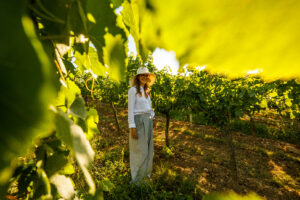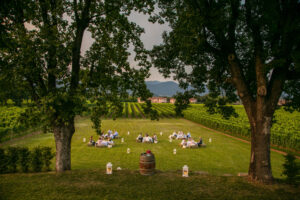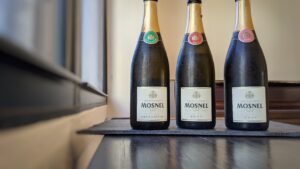The endless festively decorated convention stands where various Italian wines were being poured had tons of laughter and boisterous conversations emanating from them bringing an electricity that created a new magical world for a five-year-old girl. It was 1974 and she was there with her brother and mother at a wine trade fair called Vinitaly in the romantic city of Verona, located in the region of Veneto in Italy; it was Vinitaly’s seventh year of showcasing the fantastical array of Italian wines to international wine buyers and journalists. Although this little girl came from her own magical world in the province of Brescia, which lies in the northwestern Italian region of Lombardy, she was not used to such liveliness as she lived tucked away in the countryside surrounded by her family’s vineyards and she had never experienced such frenetic energy; it seemed she lived the best of both worlds as she was transported to ancient times when she played in her family’s 16th century stone wine cellar, counter-balanced with the excitement of witnessing her mother introduce their traditional sparkling wines to the rest of Italy and eventually to the world.
That young girl grew up to be Lucia Barzanò and she would end up working side by side with her brother Giulio, the winemaker of their family winery, to continue their mother’s mission when it comes to making some of the greatest traditional sparkling wines in the world that are meant for long-term aging from the high-quality designated appellation of the Franciacorta DOCG.
Mosnel Franciacorta Wines
The name Franciacorta is known among many Italian wine drinkers as one of the best sparkling wines and Lucia says that, many times, when Italians want a top sparkling wine when they go to a nice restaurant in Milan or Rome they will specifically ask for Franciacorta by name. Lucia’s mother’s side of the family has been in what is now considered the Franciacorta wine area, one of the top sparkling Italian appellations, since 1836 and Lucia with her brother are 5th generation winemakers running their Mosnel family winery.
Lucia’s mother, Emanuela Barzanò Barboglio, was an important force in establishing what Franciacorta is today as she was one of the 11 producers to be part of being awarded DOC high-quality status for the wines of Franciacorta and then she became part of the lobbying process to receive the highest-quality status for only their sparkling wines with DOCG which was awarded in 1995. Today Lucia, with her brother Giulio, continue the few tenets that their mother established: decent percentage of Pinot Blanc (Pinot Bianco in Italian), low sugar dosage and longevity built into the wines.
As Lucia likes to note, Franciacorta has a multitude of deep meaning for Italians as it is part of the culture of the area as sparkling wines have been made there since the 16th century and on a personal note, her mother’s family has been making these wines for almost 200 years, as well as Franciacorta being a designated place that has been recognized for top sparkling wine and finally it is a method of production as well – that deep meaning translates to today Italy representing 80% of Mosnel sales. The Franciacorta method is similar to the Champagne method as it goes through its second fermentation in bottle and then it spends many months in that same bottle aging on its lees (sediment left after fermentation that adds complexity) but for Champagne, the minimum for Non-Vintage is 15 months of lees aging where Franciacorta enforces a minimum of 18 months – Mosnel goes even further with a minimum of 24 months; both regions use Chardonnay and Pinot Noir (Pinot Nero in Italian) for the majority of the blend but Franciacorta allows Pinot Blanc to be used. And Pinot Blanc is an important aspect to the Mosnel style as it gives a fuller body that assists with long-term aging as well as giving pretty floral aromatics when it is properly grown.
Today Mosnel has almost 100 acres of vineyards that are organically farmed and the composite of their estate vineyards break down to 70% Chardonnay, 15% Pinot Noir and 15% Pinot Blanc with only their estate vineyards being used for their wines. They are one of the few wineries that use such a high percentage of Pinot Blanc and so that is one of the reasons it distinguishes Mosnel from many other Franciacorta producers. But as climate change makes the summers warmer, Lucia and her brother have been looking for other ways to keep the fierce acidity that is preferred for such premium sparkling wines and they have found the “ancient, local variety” called Erbamat as a possibility for the future as it has higher acidity levels.
Part of the incredible ageability for Mosnel Franciacorta sparkling wines is due to a part of the wines fermenting and aging in small French used oak barrels as well as the low sugar in the whole range of the Mosnel wines. Just like in Champagne, when the wines are disgorged to remove the sediment of the lees after a certain amount of time of aging, a small amount of wine needs to be added to take up what volume was removed with the sediment and at this time sugar (a.k.a. dosage) is also added. The sugar many times counter-balances the high acidity in Champagne wines as well as in Franciacorta wines but Mosnel will only have, for example, four grams of sugar per liter in their Brut which is less than half of what the average dosage is in Brut Champagne. Actually Mosnel currently has five different bottlings of Franciacorta that have no sugar added that range from a Brut Nature to a handful of different Vintage Franciacorta to a Riserva that ages ten years on the lees as the wines are already balanced without any sugar added.
According to Lucia, they believe that the low amount of dosage, or none at all, helps make their wines built better for age; the final thing that makes their wines age-worthy is the use of reserve wines added to the blend that average around ten years old, giving more depth and concentration to the final blend.
Built to Last
It was such a special upbringing for Lucia as, from a young age, she was able to see her mother change an industry by showing Italy that they were capable of making great sparkling wine. And Lucia couldn’t be prouder than to follow in her mother’s footsteps as well as working with her brother who she is always ready to brag about as being one of the most talented winemakers she knows; her pride runs even deeper with her two daughters working at Mosnel becoming the 6th generation. At one time, getting Italians at fine dining restaurants in Italy to drink any other bubble than Champagne was impossible but Lucia’s mother was able to make Franciacorta a household name. Of course there is still that bridge to overcome in the U.S. market as, for many Americans, even dining in Italian restaurants, the name Franciacorta means very little; so for now Mosnel is sold as a small family production, estate-grown, organic premium Italian sparkling wine and that seems to get a lot more attention. But just like her mother, Lucia is happy to take on the challenge and she will not give up on the idea that one day Franciacorta will have the same deep meaning as it does in her home country.
Mosnel, Brut Nature, Franciacorta DOCG, Lombardy, Italy: 70% Chardonnay, 20% Pinot Blanc and 10% Pinot Noir. No dosage. Saline minerality, chamomile and lemon rind on the nose with fine bubbles and intense minerality with crisp acidity.
Mosnel, Brut, Franciacorta DOCG, Lombardy, Italy: 60% Chardonnay, 30% Pinot Blanc and 10% Pinot Noir. 4 grams per liter dosage. The Brut has more weight, more flavors with juicy nectarine and more of a background note of minerality that isn’t as intense in the Nature with a lovely expressive finish of roasted almonds.
Mosnel, Brut Rosé, Franciacorta DOCG, Lombardy, Italy: 40% Pinot Noir, 40% Chardonnay and 20% Pinot Blanc. 5 grams per liter dosage. Fresh strawberries with warm raspberry and stony minerality, elegant with pristine fruit flavors and a fantastic freshness – takes you to the edge of giving good intensity of fruit but doesn’t go too far keeping lots of acidity and minerality in play.














